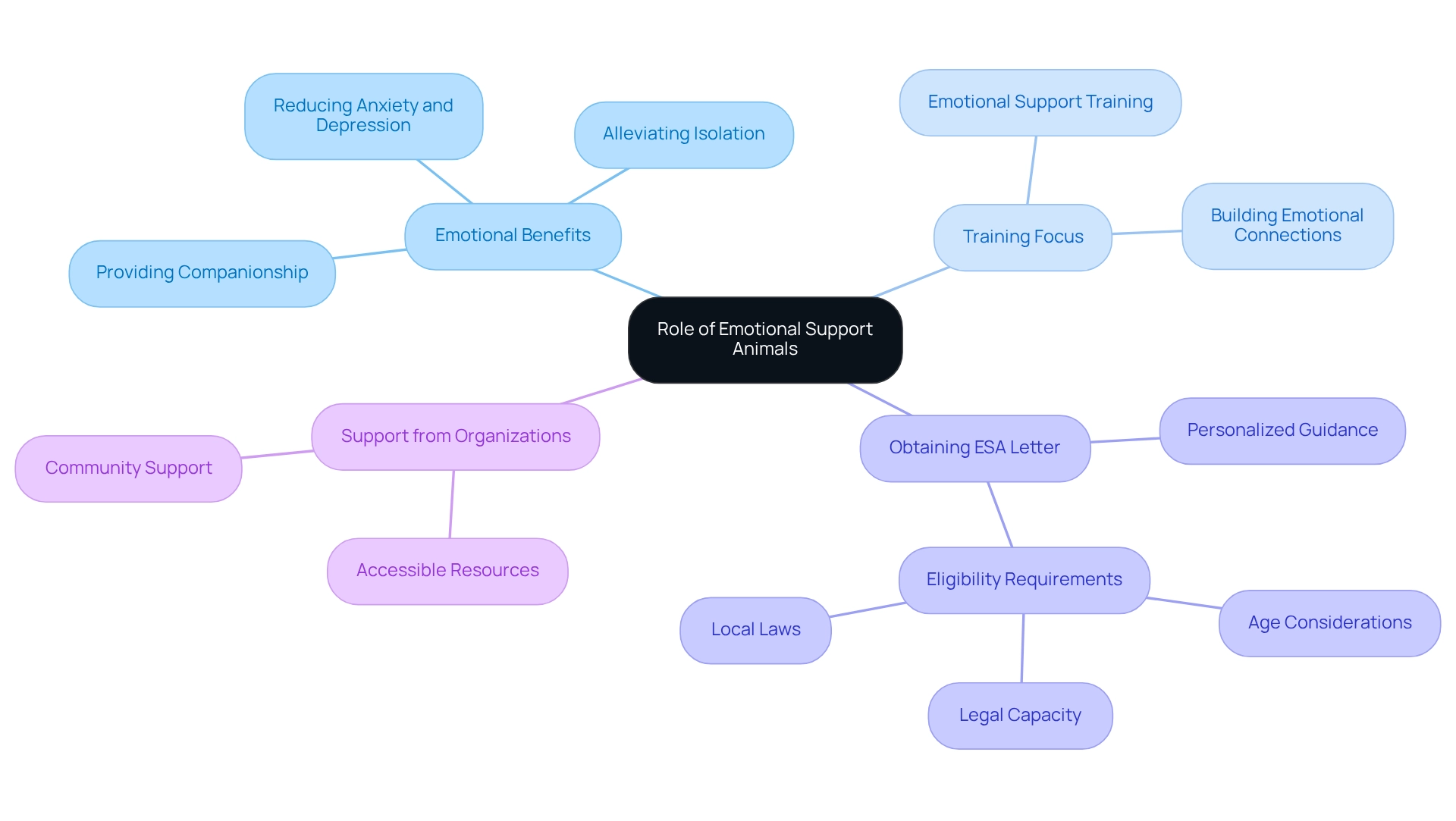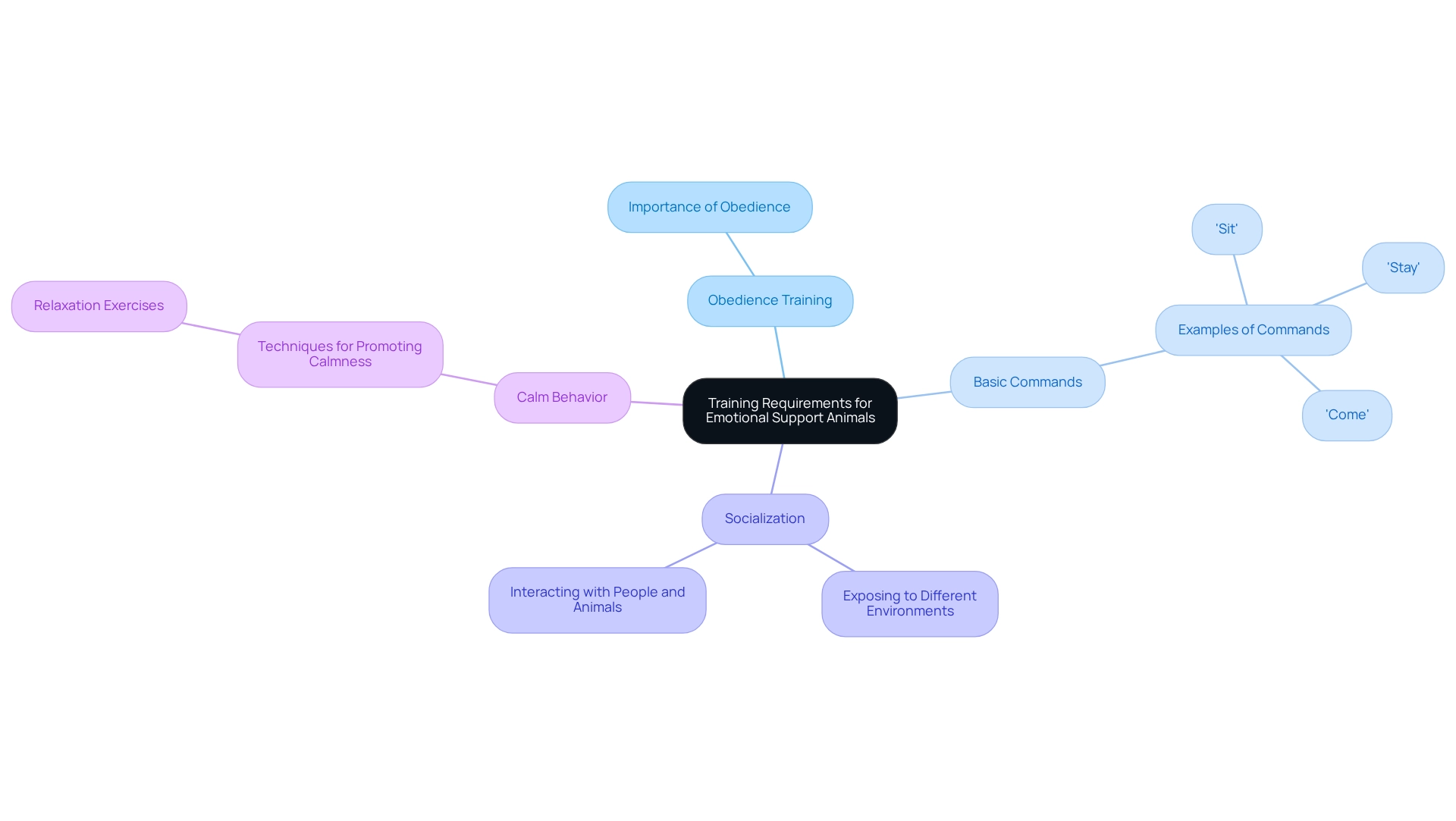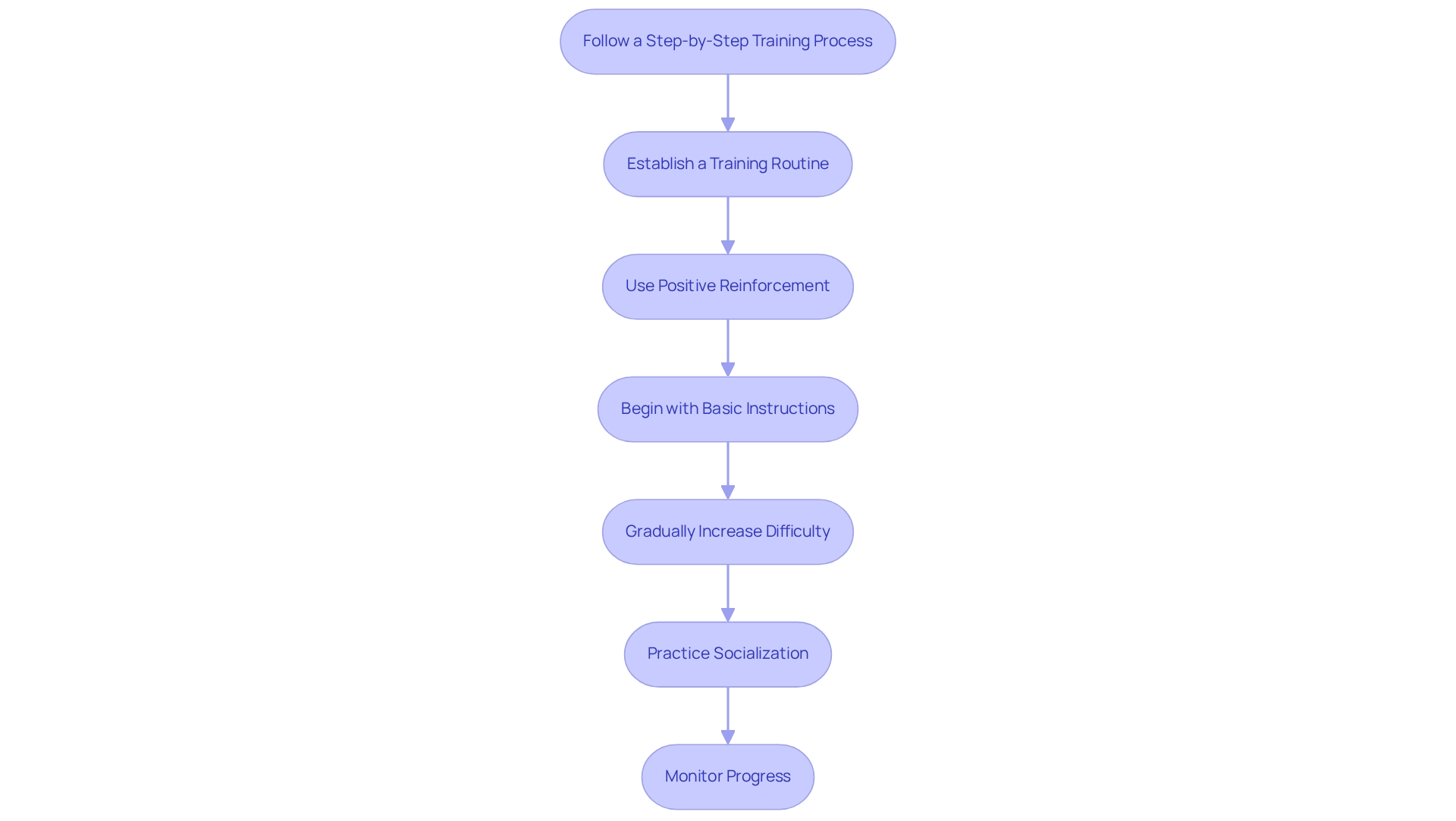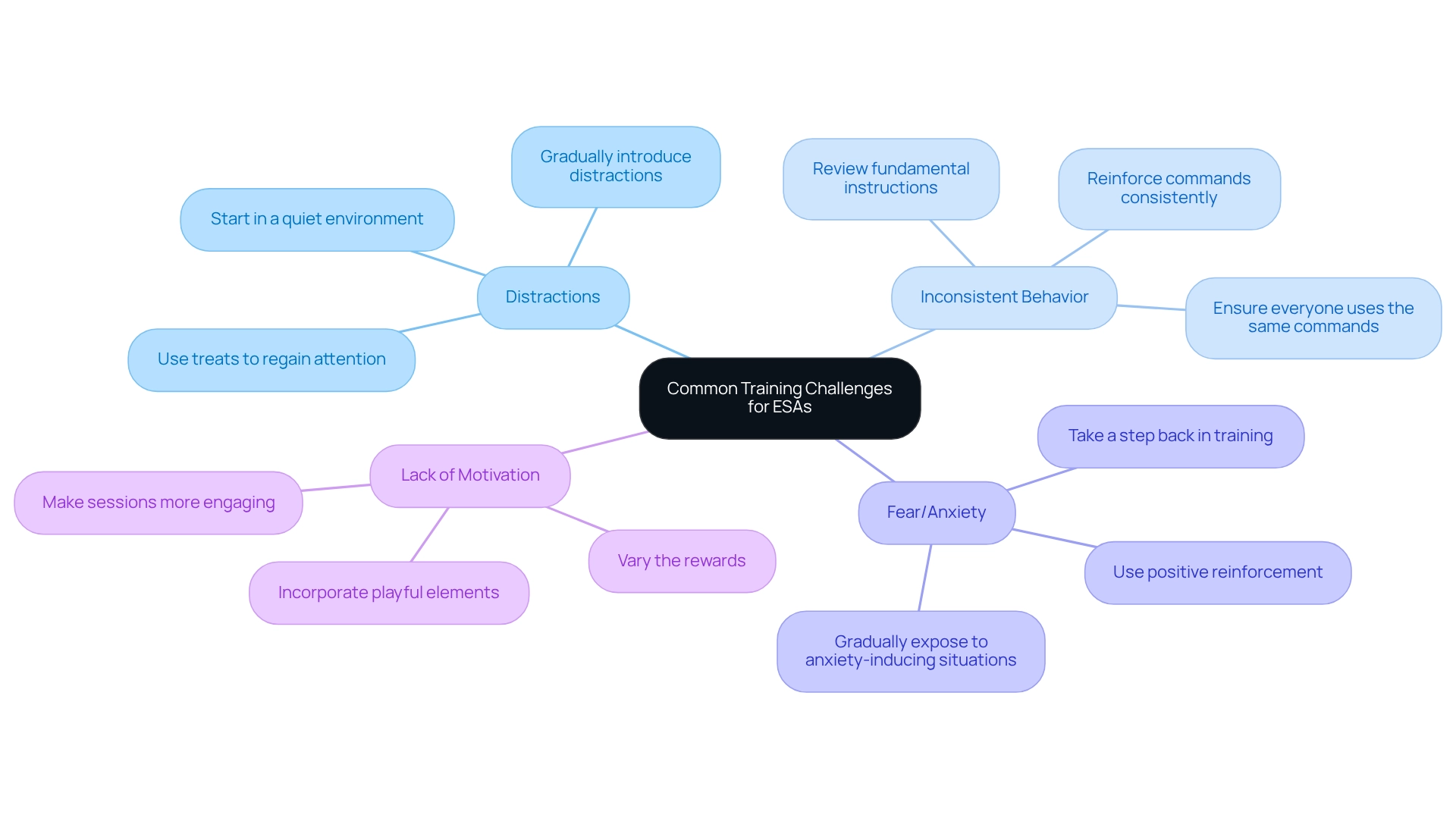

4 Steps for Effective ESA Dog Training to Support Mental Health
by Lena Park
Last updated: June 6, 2025
Verified and Approved by:
Angela Morris,
MSW, LCSW
Fact Checked

Overview
This article highlights four essential steps for effectively training emotional support animals (ESAs), aimed at enhancing their ability to support mental health. It begins by acknowledging the emotional challenges many individuals face, emphasizing the need for consistent training routines.
Utilizing positive reinforcement is crucial, as it not only teaches the ESA but also strengthens the bond between the animal and its owner.
Teaching basic commands forms the foundation of effective communication, ensuring that the ESA can respond reliably when needed.
Additionally, addressing common training challenges is vital, as it fosters resilience and adaptability in both the animal and its handler.
Ultimately, these steps are designed to ensure that the ESA can provide the reliable emotional support that individuals may deeply need during difficult times.
Introduction
In a world where mental health challenges are increasingly recognized, many individuals find themselves struggling with feelings of anxiety, depression, and loneliness. These emotional hurdles can often feel overwhelming and isolating. However, emotional support animals (ESAs) have emerged as vital companions, offering comfort and solace to those in need. Unlike service animals trained for specific tasks, ESAs provide invaluable emotional support simply through their presence, helping to alleviate these difficult feelings.
Navigating the journey of obtaining an ESA and effectively training them can be daunting, but it is a path worth exploring. This article delves into the essential aspects of understanding the role of ESAs, identifying their training requirements, and troubleshooting common challenges. By empowering individuals to foster a meaningful bond with their furry friends, we can enhance overall well-being and provide the support that is so crucial in these moments of need.
Understand the Role of Emotional Support Animals
Emotional assistance animals (ESAs) play a vital role in providing comfort and companionship to individuals facing mental health challenges. For many, the struggle with anxiety, depression, and loneliness can feel overwhelming. Unlike service dogs, which are trained to perform specific tasks for individuals with disabilities, ESA dog training focuses on enabling emotional support animals to provide emotional support through their presence. They can help alleviate feelings of isolation, making them invaluable companions for those in need.
At Wellness Wag, we recognize that the journey to obtaining an Emotional Support Animal Letter is crucial for many individuals seeking this companionship. It’s not just about the letter; it’s about the emotional connection and support that an ESA can provide. Our mission is to empower you with accessible resources and personalized guidance, ensuring you can navigate the eligibility requirements effectively. This includes understanding aspects such as age, legal capacity, and local laws.
Acknowledging the function of ESAs influences not only the development method but also strengthens the emotional connection and assistance provided by the animal, steering the process efficiently. Together, we can create a supportive environment where the transformative power of ESA dog training companionship is embraced. Remember, you are not alone on this journey; we are here to help you every step of the way.

Identify Training Requirements for Your ESA
While emotional support animals may not be required by law to undergo formal training, equipping them with specific skills can significantly enhance their ability to provide comfort, particularly for students with disabilities. Fundamental obedience training is crucial in ESA dog training, as it ensures that your ESA can respond to commands and behave appropriately in various situations, thereby supporting mental health and facilitating housing access.
Consider starting with basic commands. Teaching your ESA dog training commands such as ‘sit’, ‘stay’, and ‘come’ helps maintain control in various scenarios, ensuring that your ESA remains a reliable source of emotional support.
Socialization is another important aspect. By exposing your ESA to diverse environments, people, and other animals, you help them become well-adjusted and calm in various settings. This adaptability is essential in fostering a positive living experience in student housing.
Promoting calm behavior in your ESA, especially during stressful situations, is vital. This ability ensures they can provide the necessary emotional support when it matters most. For students who rely on their ESAs to help alleviate symptoms related to their conditions, this calming presence can be invaluable.

Follow a Step-by-Step Training Process
To effectively train your emotional support animal, consider these gentle steps:
-
Establish a Training Routine: Set aside dedicated time each day for training sessions. Consistency is key to reinforcing learning and helps build a trusting bond between you and your dog through ESA dog training.
-
Use positive reinforcement in ESA dog training: reward your ESA with treats, praise, or playtime when they successfully comply with a request. This not only encourages them to repeat the behavior but also strengthens your connection.
-
Begin with Basic Instructions: Start with simple cues like ‘sit’ and ‘stay’. Use clear, consistent instructions and gestures to guide them, fostering a sense of security and understanding.
-
As they progress in ESA dog training, gradually increase difficulty: Once your ESA masters basic commands, introduce more complex tasks, such as walking calmly on a leash or responding to cues in distracting environments. This helps them grow in confidence and adaptability.
-
Don’t forget to Practice Socialization: Regularly expose your ESA to new experiences, people, and other animals. This will help them become comfortable in various situations, making them feel more secure in their surroundings.
-
Monitor Progress: Keep track of your ESA’s advancement and modify your methods as necessary to ensure they are learning effectively. Celebrate their achievements, no matter how small, as each step forward is a testament to your partnership.

Troubleshoot Common Training Challenges
Training an emotional support animal can indeed present its challenges, and it’s important to recognize these hurdles with compassion. Here are some common issues you might encounter and gentle ways to address them:
-
Distractions can be particularly frustrating. If your ESA finds it hard to focus during training, consider starting in a quiet environment. Gradually introduce distractions as they become more comfortable, and use treats to help regain their attention when needed.
-
Inconsistent behavior is another concern. If your ESA displays erratic actions, take a moment to review fundamental instructions and reinforce them. It’s essential that everyone in your household uses the same commands to prevent any confusion and ensure a harmonious training experience.
-
Fear or anxiety in your ESA can be disheartening. If you notice signs of distress, it’s okay to take a step back in the training process. Employ positive reinforcement to help build their confidence, and gradually expose them to the situations that may be causing their anxiety.
-
Lastly, a lack of motivation can be a barrier to progress. If your ESA seems disinterested in the training sessions, consider varying the rewards or incorporating playful elements into your practice. Making the sessions more engaging can rekindle their enthusiasm.
By proactively addressing these challenges, you can create a smoother training experience for both you and your emotional support animal through esa dog training, fostering a deeper bond and understanding between you.

Conclusion
Emotional support animals play a vital role in the lives of those facing mental health challenges, offering comfort and alleviating feelings of anxiety, depression, and loneliness. Acknowledging these emotional struggles is the first step toward building a meaningful connection that can significantly enhance overall well-being. By understanding the invaluable support that ESAs provide, individuals can navigate the process of obtaining an ESA letter, ensuring they meet the necessary eligibility requirements, and paving the way for a nurturing relationship.
While formal training is not a requirement for ESAs, equipping them with basic obedience and socialization skills can greatly enhance their ability to offer emotional support. Establishing a consistent training routine, utilizing positive reinforcement, and gradually increasing the complexity of commands can result in a well-adjusted and reliable companion. These foundational skills not only facilitate a positive living experience but also strengthen the bond between the individual and their ESA.
Training an emotional support animal may come with its challenges; however, addressing these with patience and proactive strategies can lead to success. By troubleshooting common issues such as distractions or inconsistent behavior, individuals can create a more effective training environment. Ultimately, the journey of training an ESA transcends mere command teaching; it is about nurturing a lasting relationship that fosters mental health and emotional well-being. Embracing the support of an ESA can truly transform lives, underscoring the profound importance of companionship in navigating life’s emotional hurdles.
Frequently Asked Questions
What is the role of Emotional Support Animals (ESAs)?
Emotional Support Animals provide comfort and companionship to individuals facing mental health challenges, helping to alleviate feelings of anxiety, depression, and loneliness.
How do ESAs differ from service dogs?
Unlike service dogs, which are trained to perform specific tasks for individuals with disabilities, ESAs focus on providing emotional support through their presence.
What is the importance of obtaining an Emotional Support Animal Letter?
Obtaining an Emotional Support Animal Letter is crucial for individuals seeking companionship, as it formalizes the emotional connection and support that an ESA can provide.
What resources does Wellness Wag offer for obtaining an ESA Letter?
Wellness Wag provides accessible resources and personalized guidance to help individuals navigate the eligibility requirements for obtaining an ESA Letter.
What factors should be considered when determining eligibility for an ESA?
Eligibility for an ESA involves understanding aspects such as age, legal capacity, and local laws.
How does acknowledging the function of ESAs benefit individuals?
Acknowledging the function of ESAs strengthens the emotional connection and assistance provided by the animal, making the process of obtaining one more efficient and supportive.
What support does Wellness Wag offer during the journey of acquiring an ESA?
Wellness Wag offers guidance and support throughout the journey, ensuring individuals feel empowered and not alone as they seek the companionship of an ESA.
Certify Your Emotional Support Animal Today

Why You Can Rely on Us?
At Wellness Wag, we believe your pet deserves care rooted in both science and compassion. Each article is carefully researched, written in clear language for pet owners, and then reviewed by qualified professionals to ensure the information is evidence-based, current, and practical for real-life care. Our goal is to help you feel confident in making informed decisions about your pet’s health and well-being.
Reviewed by
Angela Morris, MSW, LCSW
Angela is a licensed clinical social worker with 20 years of experience in patient advocacy and community mental health. She has assisted numerous clients with ESA evaluations and brings a deep understanding of disability accommodations, ensuring that all information is accurate, supportive, and practical.

Written by :
Lena Park
Last Updated :
June 6, 2025












